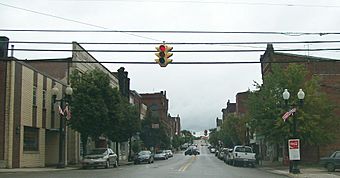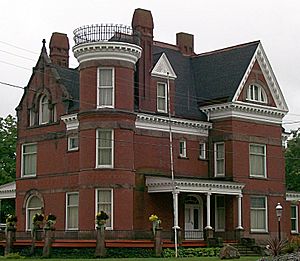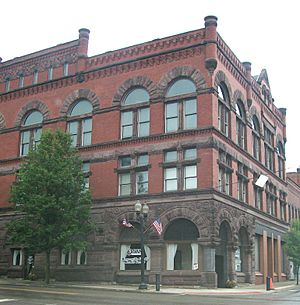Barnesville Historic District facts for kids
Quick facts for kids |
|
|
Barnesville Historic District
|
|

View east of downtown Barnesville, Ohio.
|
|
| Location | Roughly bounded by Arch, Main, Gardner, Chestnut, Bond and Cherry Sts., Barnesville, Ohio |
|---|---|
| Area | 40 acres (16 ha) |
| Built | Various times |
| Architect | Multiple |
| Architectural style | Late 19th and 20th century revivals, Greek Revival, Late Victorian |
| NRHP reference No. | 84002899 |
| Added to NRHP | July 19, 1984 |
The Barnesville Historic District is the oldest part of Barnesville, Ohio. It was first planned in 1808. This special area covers about 40 acres and includes 180 buildings. Many of these buildings are very old and have interesting stories. The district was added to the National Register on July 19, 1984. This means it's officially recognized as an important historical place.
Contents
Discovering Barnesville's Past
How Barnesville Began: 1800s to 1860s
The land around Barnesville was first settled by pioneer families in the early 1800s. Most of these settlers were Quakers. They came from places like Maryland, Pennsylvania, and the southern states. These early families built a meeting house and a cemetery. This small settlement caught the eye of a farmer from Maryland.
His name was James Barnes. In 1808, he decided to create a new Quaker town here. He found a perfect spot with rolling hills along a Drovers' road, which was a path used for moving animals. James planned out the streets and lots for his new town. His brother, David, also joined him. The Barnes brothers owned a lot of land. They helped the town grow by owning a tannery, a brick yard, mills, and farms.
James Barnes later went back to Maryland. But his brother, David, stayed. He became the mayor of the growing town. He lived on Main Street. Many of the very first buildings from this time are gone now. They were replaced by the beautiful Victorian buildings you see today. More people moved to Barnesville in the mid-to-late 1800s. They were looking for more space than the busy East Coast. In 1857, a railroad line was built through the town. This led to a big increase in Barnesville's population.
Barnesville Grows with Industry: 1860s to 1950s
The railroad brought new factories and more people to Barnesville. Companies like Watt Car and Wheel Company, The Eastern Ohio Glass Company, and Hanlon Paper Company moved in. The town quickly grew bigger. Its original plan was expanded to the north and south. The town grew so much that the B&O Railroad built a new train station in 1916. This station, called the Barnesville B&O Railroad Depot, is also a historic site.
Many of the buildings you see today were built during this time. This gives Barnesville a special look from after the Civil War. Many churches were also built. They show the different religious groups that helped Barnesville grow. Today, the town has 12 different churches.
Barnesville grew even more during the World Wars. The country needed more goods for the war effort. The Watt Car and Wheel Company made more coal-mining equipment. They also started making parts for vehicles. The Glass Company also made more products for vehicles and ships. After World War II, the town's growth slowed down.
Changes and Comeback: 1950s to Today
After the Korean War ended, the demand for war-time products decreased. Many businesses in Barnesville closed over the next few decades. In the late 1960s and early 1970s, some older buildings were torn down. Large warehouses were replaced with houses and smaller shops.
But Barnesville started to recover in the late 1980s and early 1990s. The town has worked hard to keep its historical buildings. This has created a strong sense of pride in the community.
Exploring the Historic District Today
Many buildings in the district today are from the Victorian era. The district includes several well-known buildings. These include the Bradfield Building, which used to house WesBanco, and the Barnesville Municipal Building. The Belmont County Victorian Mansion Museum is also here. Many private homes are part of the district too. In total, there are 198 structures. This includes 180 important historic properties. The Barnesville Railroad Tunnel is also part of the district. It runs under East Main and Arch Streets.
A big part of the district is used for the Annual Barnesville Pumpkin Festival. This festival happens every September. West Main Street is where the giant "King Pumpkin" is displayed!
Special Historic Buildings to See
- Barnesville Presbyterian Church at 124 North Chestnut Street – This church has a unique design. It looks a bit like a Chinese pagoda. It was built by Frank Packard.
- Belmont County Victorian Mansion Museum at 532 North Chestnut Street – This is a large, impressive house. It was built in the Romanesque Revival style. It belonged to the important Bradfield family.
- The Arthur Rogers House and Thomas Rogers House at 502 and 520 North Chestnut Street – These are the last two houses in Barnesville built in the Second Empire style.
- Bradfield Building at 101 East Main Street – This building is also in the Romanesque Revival style. It was built for the First National Bank of Barnesville.
- Barnesville Municipal Building at 132 North Arch Street – This Romanesque Revival building is also historic. It is the only important building not located within the district's main boundaries.





